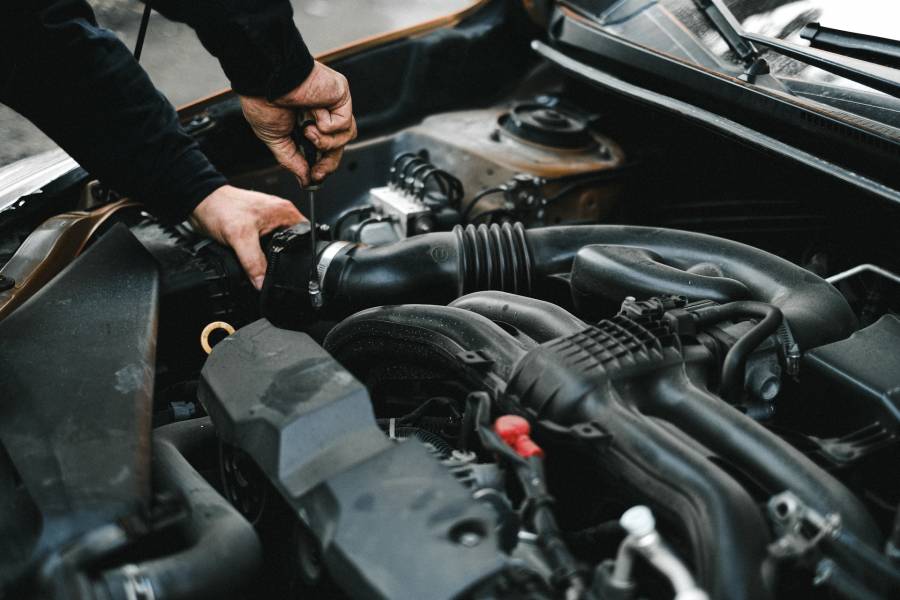Quick Navigation
The engine oil pressure control circuit can fail to close or open. It can harm the engine oil filter, and the damage can also extend to the engine.
If it is stuck open, too much oil can cause a bleed-off. It can reduce oil pressure and damage the engine.
The problem is relatively standard, so it is nothing to fret about.

This write-up will show you what causes the problem and how you can resolve it.
You should be able to handle most of the resolutions by yourself without involving a technician.
Causes Of The Engine Oil Pressure Control Circuit Stuck Off
The possible reasons are many, and we will mention some of them below.
Damage To The Sensor
Damage to the engine oil pressure sensor can prevent a quick detection of engine oil level, which can cause the engine oil pressure control circuit to get stuck.
Engines with dual-stage oil pumps are equally susceptible to the problem.
Low Engine Oil
The problem can be due to a low level of engine oil. The engine oil pressure control circuit may also become faulty if you use an incorrect engine oil filter.
Mechanical faults in the engine’s oiling system may lead to insufficient oil pressure.
If an error code P06DD shows up on the diagnostic tool, you can confirm the problem. The error code confirms a low engine oil level or oil spillage in the engine.
It equally confirms using the wrong oil filter, which occurs when unprofessional technicians replace your oil filter.
Even if the technician uses the correct oil filter, the problem will still occur if the oil filter is not fixed correctly; some technicians may make the mistake of fixing the oil filter upside down.
When the engine oil pressure control circuit is stuck due to the problems described above, the car can still move, but the engine will not pick up since it is starved of oil.
Bad Oil Filter
A dysfunctional engine oil pressure control circuit may be due to a faulty oil filter. This problem also occurs if the wrong oil filter is used.
Using an unskilled technician can cause a problem.
Helpful Solutions
Follow the steps below to resolve the issue.
Check And Replace The Oil Pressure Sensor
You will need first to remove the oil pressure sensor and then install a mechanical oil pressure gauge.
When replacing the sensor, make sure you use the specific sensor for that engine and not an aftermarket sensor.
Using an aftermarket sensor may predispose the entire to the problem again.
The damage may be more extensive this time around too, which you do not want to happen. Avoid making it too tight when fitting the sensor, but just tight enough.
The entire fixing of the sensor will also not take a long time.
Some cars come with instructional guides on how to replace the sensor. You can follow the instructions to end the engine oil pressure control circuit problem.
Consequently, you will not have to involve a mechanic to do this for you.
Check And Replace The Oil Filter
You should also consider replacing the oil filter if it is damaged or wrongly installed. You can check the oil pressure after.
Check the dual-stage oil pump, too, to know if it is within specs. If not, you will have to replace it.
If it is within spec, the problem must be due to an internal engine issue, like rod bearings or cranks that are out of spec.
It may also be because of dirt build-up in the oil passage.

Check The Engine And Oil
Low engine oil is one of the significant causes of engine oil pressure control circuits stuck off.
So, it is essential to check the engine oil level lest the problem reoccurs in the future. Remember that low engine oil can cause irreparable damage to the engine.
Switch off the ignition and check the items highlighted below before proceeding. If you fail to include any of the points below, it will result in misdiagnosis.
- Check the engine oil viscosity.
- Check if the engine oil is contaminated
- Check if it is dirty or deteriorated
- Check if the engine oil filter meets the OEM specifications
- Check if the engine oil is aerated
- Also, check the engine oil level
If any of the points above are present, you should repair the engine oiling without delay.
Assess the engine’s mechanical condition, like a seal, pick-up tube, damaged oil pump, oil sludge, improper oil drain back, etc.
When refilling the engine oil pan, always use the engine oil recommended for the car.
You can find this information in the user manual or contact an experienced technician.
Check For Active Diagnostic Trouble Code (DTC)
To do this, make sure the engine oil is at the right level and also use only the specified oil filter.
Check if oil change happens at the regular interval without overlooking the oil’s viscosity. Kick the engine to live and let it reach its average operating temperature.
You should avoid standing in the same line as the fan while the engine is on. You should also avoid bringing your hands close to the fan, belts, or pulleys.
Avoid wearing loose clothing close to the fan to avoid fatal injury. It would help if you perfected or drove the car according to the set condition.
Dual-Stage Oil Pump
The dual-stage oil pump comprises the solenoid and pump. The two components are not serviceable too.
So, you must replace them if they fail to function accordingly. Erase the DTC using a scan tool.
Next, operate the car according to the set conditions and read out the DTC using the scan tool.
If the DTC still shows the P06DD code, replace the Dual Stage Oil Pump assembly and carry out the power train verification test.
If not, you should still carry out the power train verification test.
Power Train Verification Test
Start by erasing all DTC using the scan tool after completing the repair.
You can now navigate to Miscellaneous Functions using the scan tool band to carry out all the relevant routines or procedures related to the system or components you have repaired.
If the PCM is replaced, you should program the odometer, VIN, and secret key code.
Check the vehicle to ensure all engine components are installed and connected correctly. Where necessary, reassemble and reconnect the components.
Then operate the vehicle in line with specific information available in the theory of operation and monitoring conditions of the DTC you have repaired.
Check if there is no DTC again using the scan tool.
If there are still any DTC, check any service bulletin related to the DTYC and carry out the proper diagnosis.
If there is no DTC again, the powertrain verification test is complete.
Conclusion
It would help if you resolved the engine oil pressure control circuit stuck-off problem very fast because of the danger it poses to the engine.
The scan tool can help you detect the problem quickly and suggest solutions.
If you are new to automobile repairs, it is better to trust qualified auto mechanics to help out.
They can complete the repair without causing any further damage to the engine.
It would be best to have the scan tool handy for instant response when the problem shows up.

With comprehensive experience in writing exceptional quality articles and blogs about cars and related stuff, Daniel is one of the finest bloggers and a hardcore car lover we have. He is an ASE certified technician with an across-the-board experience of 10 years in the industry. He could not help tinkering with anything he got his hands on from a young age, which led to his remarkable career in the automotive repair industry.
When he is not under any hood, you can find him on the water or in the woods to pursue his passion for hunting and fishing. He has been writing for multiple sectors and is a regular contributor to several publications.
He currently owns a Nissan 300ZX TT and a Pearl Yellow but plans to upgrade it to 550 HP. His favorites include the Koenigsegg CCX and Lamborghini Diablo 6.0 VT, but for him, the Ferrari 360 Spider is one of the sexiest cars that exists to date.
Being an avid world traveler, he has spent most of his time analyzing the automotive markets, latest technology, and local favorites to enhance his knowledge base. He is currently living in North Caroline, where it’s all about food and coffee and, of course, cars.






